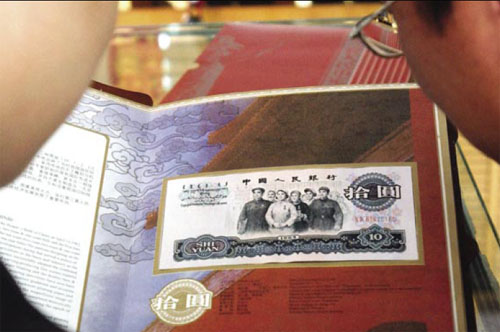Business
More banking on old money as faith in economy fades
(China Daily)
Updated: 2010-09-02 17:40
 |
Large Medium Small |
|
 Collectors look at a third-series 10-yuan note in a currency market in Zhengzhou. The number of currency collectors in China is rising. Sha Lang / For China Daily |
BEIJING - At the Wanjia Madian stamp and currency market, yuan notes are treated with kid gloves and are never subjected to cash-counting machines.
This is because the notes the traders handle are no longer in circulation. To collectors, they are worth thousands more than their face value.
For example, a pristine 5,000-yuan note in the first series of yuan notes, issued in 1948, can fetch as much as 650,000 yuan ($95,450), said Li Zhidong, deputy general-secretary of the Beijing Numismatic Association.
"We really don't know how many of the first series of notes have survived or are in the hands of collectors," he said.
The number of currency collectors in China is rising as the appetite for old yuan notes increases as more people are beginning to see the notes as an investment.
Xu Zenghui, a business owner from Anhui province, paid 262,000 yuan for a set of the fourth series of yuan notes, with 100 pieces of the 1980-issued 50-yuan notes.
"It should be safer than investing in the unstable stock and property markets," said Xu who lost money on stock market in April and is concerned the government may introduce a housing tax on additional properties.
"Buying old yuan notes is perhaps the best way to invest right now," Xu said.
Prices for old yuan notes depend on their series and years of issue.
China has so far issued five series of yuan notes, with only the latest series, the fifth featuring Mao Zedong's portrait, the legal currency. The previous four have been withdrawn from circulation.
The first, which features mainly agricultural, mining, transportation and industrial pictures, was in circulation from 1948.
The second series, which featured trucks, ships, planes and farmers, was introduced in 1955.
In 1962, the third series, depicting modern socialist agricultural and industrial construction, was issued and this was replaced by the fourth in 1987, which showed China's landscapes and ethnic groups.
"Generally, prices for the earlier series are higher as the number of notes issued in the first and second series was far fewer than the third and fourth series," Li said.
As well, within the fourth series, there is a disparity in the prices of 50-yuan notes issued in 1980 and 1990. Collectors will pay up to 2,650 yuan for a 1980 50-yuan note as fewer were issued; the more common 1990 note is worth 170 yuan.
Li said the third and fourth series dominate the market and their prices are relatively acceptable for collectors and investors.
Qin Zhiqing, a retailer at Wanjia Madian, said prices are determined by the quality of the note, its series, year of issue, watermark, printing technique and denomination.
"Numbers considered luck by the Chinese, such as six or eight, in the serial number also play a key role in prices," he said.
Higher prices can also be achieved if a particular denomination is part of a series of at least 100 notes, with consecutive series numbers.
In May, a set of 100 third-series 2-yuan notes was sold for 140,000 yuan at an auction in Beijing.
Lu Ang, CEO of Artrade Online Auctions Co Ltd, said Chinese people are beginning to enjoy collecting old yuan notes.
She said collectors like the fact that notes reflect the nation's economic, political, ethnic and cultural history, with each representing a different era.
Zhang Yuxin, a collector and member of the China Numismatic Association, said that while it is against the law to trade the present series of the yuan, notes with "lucky" serial numbers, such as those ending with 1888, can fetch high prices and are being quietly traded.
Commemorative yuan notes also have a strong appeal. "A 50-yuan note for the 50th anniversary of the founding of the People's Republic of China, issued in 1999, is worth 150 yuan and a green 10-yuan note with the Bird's Nest Olympic stadium is 1,400 yuan," retailer Chen Peng said.
China Daily